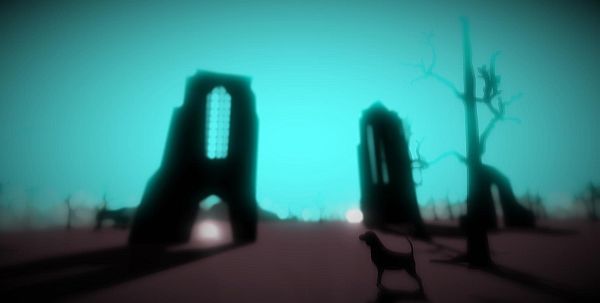Impressions: Ruins
A Dog's Life
Cardboard Computer, the indie developer behind A House In California, has created Ruins, a short, desolate game in which you play a dog. Chasing some rabbits. But there's a little more to it than that.
Ruins certainly falls under the usual use of the label, "art game". An unhelpful label, certainly, and one I'd prefer we do without. It only encourages people to start discussing the subject of art, and that's always a tedious affair. Instead, I'd like to call them "ideas games", which is equally as unhelpful and ludicrous. Because Ruins, like other short, esoteric games, is about engaging with ideas, rather than solving puzzles or winning fights.
The game is essentially about three things. Chopin, memories, and sadness. And the three intertwine. However, what the sadness is actually about is something revealed as you play, so discussion of it here seems inappropriate. And of course you play as a dog. A dog that chases rabbits, and upon meeting them, listens to what they have to say.
What stands out first is quite what a realistic dog it is you play. The game's sparse world glows gorgeously, a dream-like ethereal desert, dotted with trees and shapes. And you, a shadowed dog, trot about it splendidly. A simple-appearing animation captures dog movement perfectly, adding a peculiar dose of real-world into its fantasy.
That movement speed is essential too. This is a busy week for me, amongst an insanely busy month, and Jim's been away on holiday, Alec's at a studio looking at a game, and it's just Adam and me working this afternoon. That puts on the pressure, the need to get through a thing so I can get onto the next thing, make sure the site's flowing, that we're keeping up with any big news, stopping writing this to make sure the Deus Ex story gets up... A game that moves at a trot feels like an affront to the pace at which I need to be moving to keep on top of everything. Which is also something I needed. Rather than sitting hunched over my keyboard, fingers flying frantically, I found myself slumped back in my chair, one hand lazily on the left side of my keyboard, exploring at its sedentary pace. Which isn't exactly hindered by the beauty of Chopin's Prelude In A Major playing over the title screen, and Prelude #2 In A Minor during the game.
In fact, if you look at the game's instructions, point 5 instructs you that if you feel sleepy, you should go to sleep.
Lasting no more than around 20 minutes, the encounters with rabbits tell a story. Whose the rabbits' voice is is yours to discover, and that relationship between you and the voice is very much the core of the game. During the brief, thoughtful conversations, you can occasionally choose how to respond, which will steer things. Quite how much it steers things is surprising. A second play through can reveal a very different angle on the events being explored, concentrating more deeply on different themes. For instance, in my first play sculpture was never mentioned, while in the second it was a recurring topic. It certainly gives motivation to keep chasing rabbits.
It's an emotional game, and the choice of music is not simply for decoration. It's integral to the elusive plot, as well as playing a vital role in the mise en scène. But it's also a smart game, well made. The camera drifts intelligently, never rushing to keep up with you, but making sure it eventually swoops into the right place, the right angle, to appreciate the scenery as well as see what you're doing. A very small play area is carefully littered with shadowed sculptures, and perhaps most importantly, the black shape of a piano. The contrast with this red/black world of the glowing white bunnies is stark, and I'd suggest crucial to interpreting the dream.
Completely free, this is a gorgeous experience, and leaves me feeling far more relaxed. And sleepy.











